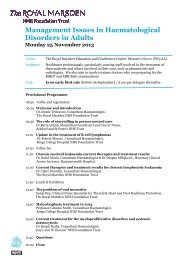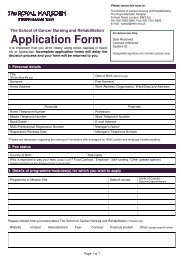Central Venous Access Devices - The Royal Marsden
Central Venous Access Devices - The Royal Marsden
Central Venous Access Devices - The Royal Marsden
Create successful ePaper yourself
Turn your PDF publications into a flip-book with our unique Google optimized e-Paper software.
Only two small cuts will be made on your chest, one to tunnel thecatheter and the other, near to your collar bone, to insert it into yourvein. You will have two stitches, one where each cut has been made.You will be told when and by whom these should be removed.After the catheter has been inserted, your shoulder may feel stiff andpainful for a couple of days. You may find painkillers help relieve thediscomfort. A chest x-ray will be taken to check that the catheter isin the right place.How do I care for the skin-tunnelled catheter exit site?<strong>The</strong> dressings are changed after the first 24 hours and then oncea week until the stitches are removed at three weeks. You will notneed to have a dressing once the stitches have been removed.However, some people prefer to tape a small piece of gauze over theexit site. This should be changed every day.You should have a shower, bath or all over wash every day to keepyour skin generally clean. If you do not shower, then you shouldclean around the exit site with cooled boiled water and cotton woolwhen you wash or when you change the gauze dressing.How do I flush the catheter?<strong>The</strong> catheter must be kept clear by injecting it (flushing) withheparinised saline. You will use 5ml (50iu) of heparinised salineonce a week. If you have a dual lumen catheter you must injectboth tubes in the way described. <strong>The</strong> injection caps will need to bechanged once a week at the time of flushing.1. Wash your hands well and dry them.2. Fit a blue needle on the end of the syringe.3. Break the heparinised saline ampoule as instructed.4. Draw up the heparinised saline and remove any air.5. Remove the needle from the syringe.6. Clean the connection between the cap and the catheter with analcohol swab, let it dry and then remove the old injection cap.7. Open the new injection cap and remove the plastic cover.12
















